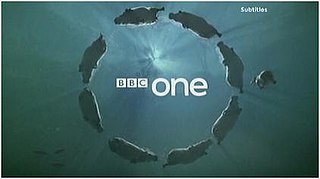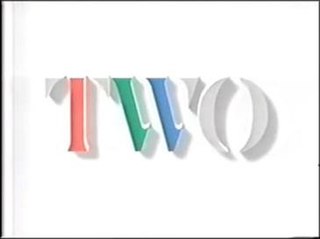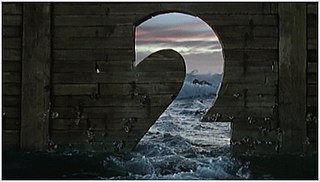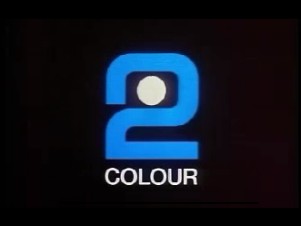| Title | Air dates | Description |
|---|
| Fish | 19 November 2001 – 18 February 2007 | Fish features an ivory 2 first rising off the floor before fish entering on screen from the right. The 2 then blows bubbles to scare the fish away, before the fish return to investigate this strange intruder. This ident was the first to be shown at 07:00. The ident was later revised after two months to swap the 2 over, who had previously been back to front during the idents. The music was generic with sound effects of bubbles when the fish swam away. |
| Bounce | 19 November 2001 – 18 February 2007 | Bounce was the most generic used of the set. It featured a 2 bouncing around the screen and in and out of the top. It bounced at different angles to a soundtrack with a low note on each bounce. Stills of this ident were used for slides, such as breakdown slides and slides containing information for the BBC Action Line. |
| Logo | 19 November 2001 – 18 February 2007 | The 2 stands vigil at the top of the screen surveying the landscape before noticing that the BBC Two logo isn't there, instead being occupied by a white square. The helpful 2 then moves over, and uses its mechanical arms to lift and flip over the BBC Two logo, before retreating to the top of the screen. On the launch of BBC Three or Four, it rotates to the BBC Three (or Four) logo. |
| Domino | 19 November 2001 – 18 February 2007 | A huge line of 2s are lined up like dominoes waiting for the 2 on the end to fall, setting off the chain. An instructor 2 blows his whistle: the end 2 wobbles, but falls the wrong way, leaving his fellow 2s stranded and the instructor infuriated. |
| Bounce Sombre | 28 January 2002 – 18 February 2007 | This ident, introduced in late January 2002, used the same graphics as Bounce but had a modified soundtrack made of base string instruments with bass drums used when a '2' bounced. This ident was introduced to introduce serious programming, such as Newsnight , following complaints by announcers concerning the lack of an appropriate ident. |
| Screen Clean | 7 February 2002 – 18 February 2007 | A dirty black spot has appeared in the middle of the screen. The 2 notices it, and goes to clean it, by breathing on it and then rubbing it off with his hand, before returning to his position. |
| Drip | 15 March 2002 – 18 February 2007 | The 2 gets dripped on by water droplets, and wherever he moves around the screen, the droplets always fall on him. The soundtrack that accompanied the music was a short, snappy techno variation of the jingle, with no soundtrack while the 2 is being dripped on. A loud dripping noise is heard each time the 2 is hit. |
| Invisible Walls | 9 May 2002 – 18 February 2007 | A 2 glides around the screen, going from left to right and disappearing behind invisible walls, only to reappear at a different point on the screen. The soundtrack is a minimal version of the jingle with surreal overtones when a 2 passes an invisible barrier. This ident was another used to introduce serious programming and gave more variety to said programmes. |
| Formation | 27 June 2002 – 18 February 2007 | A 2 slides onto a structure similar in concept to a see-saw. Another 2 then jumps on the other end propelling the 2 atop of a stack of eight 2s all balancing on a ball. The soundtrack is a comical, circus themed version of the jingle. It was used mainly for comedy programmes and introduction into CBBC and CBeebies children's strands. It was the last Personality ident to be shown before CBeebies. The following junction had the new 'Window on the World' idents. |
| Remote Control | 28 June 2002 – 17 February 2007 | A 2 comes along to find a remote control device on the floor. Upon picking it up and shaking it, he moves it, to find he controls himself. He reverses quickly, does a spin before crashing into the screen, causing the screen and BBC Two logo to get knocked, and the remote control aerial to get bent. The soundtrack was a techno rendition of the jingle. The knocked effect to the BBC Two logo was removed in 2004, when the URL was removed. |
| Drum | 3 August 2002 – 18 February 2007 | A 2 bounces up and down, as if on the skin of a drum, in time to the music: a reggae rendition of the jingle. During this, the 2 falls onto its side and upside down. This ident was created to introduce a season of programmes entitled "Jamaica 40". |
| Paintbrush | 28 October 2002 – 18 February 2007 | The 2 notices a brush sticking out from the BBC Two logo. The ever curious 2 picks up the brush, and paints a stylised '2' on the screen in the same purple as the logo. He then adds a dot in the 2 and a dot on the other side before drawing a line underneath the bottom, similar to a mouth, and another above a dot to create a face. He stands back to admire his work. |
| Sticky Label | 11 March 2003 – 18 February 2007 | A 2 notices that the logo is located in the centre of the screen at a slanted angle, as opposed to its normal bottom right position. The 2 then peels off the logo and sticks it back in its corner. However the logo is stuck to his fingers and he can't peel it off. He tries flicking it off only to have it get stuck on his shoulder where he can't see or get to it. The ident was accompanied by a twanging soundtrack and version of the jingle. |
| The Big Read | 29 March 2003 – 18 February 2007 | Six 2s are sat reading books gently and in time with each other. However, one of the 2s, who is eager to learn the plot, flicks through in a hurry to the end and then laughs softly. The other 2s then follow, and too laugh at the outcome. The ident is accompanied by a gentle flute version of the jingle and was used to introduce BBC Two's The Big Read. |
| Fire | 30 June 2003 – 18 February 2007 | A 2 moves into centre screen before sprouting a flame thrower. The background goes a dark yellow as it starts spraying fire everywhere as it reverses, going round in circles and jumping spraying fire in bursts. It stops and retracts the flamethrower, but only when it sets the BBC Two logo on fire. The background and 2 return to normal as the logo continues to burn. |
| The Big Read Crowd | 20 October 2003 – 18 February 2007 | A variation on The Big Read: instead of six 2s, there is now a whole screen full all reading. However, the centre 2 can't help but flicking quickly to the back, sparking off the rest of them. Used primarily for The Big Read. Although this ident remained in circulation after their introduction, it was rarely seen. |
| Morris Dancers | 1 May 2005 – 18 February 2007 | A 2 playing an accordion pans out to reveal six other 2s, complete with handkerchiefs, partaking in Morris Dancing. They continue to weave amongst one another and wave their handkerchiefs until the ident end. The soundtrack features the jingle before a morris style tune with electric guitar at the end kicks in. This was the final ident to be added to the regular roster before the entire set was revamped in 2007 (not counting the Frosty and Venus Fly Trap idents as they were both originally part of the 1991-2001 set). |
| Frosty | 10 February 2006 – 18 February 2007 | Used to introduce coverage of the Winter Olympics 2006, this ident featured a huge ice '2' with small white 2s skating on top of and falling off of said 2, against a blue background. This ident is not new, but in fact the BBC Two Christmas ident from 2000, albeit with the new logo. Following the games, the ident was retained and regularly used, for sporting events. |
| Venus Fly Trap | 22 May 2006 – 18 February 2007 | Venus Fly Trap begins centred on a '2'-shaped butterfly sitting within a jungle environment. The camera then zooms out, and the '2' is gobbled up by a larger '2' in the form of a Venus flytrap. The audio starts off quiet and gentle, but then builds to a crescendo as the butterfly '2' gets swallowed, before returning to quietude. This ident was part of the 1991–2001 ident set, named Predator, but was revived, albeit with the new logo. It was added to introduce the RHS Chelsea Flower Show, but was retained for programmes like Gardeners' World . |














